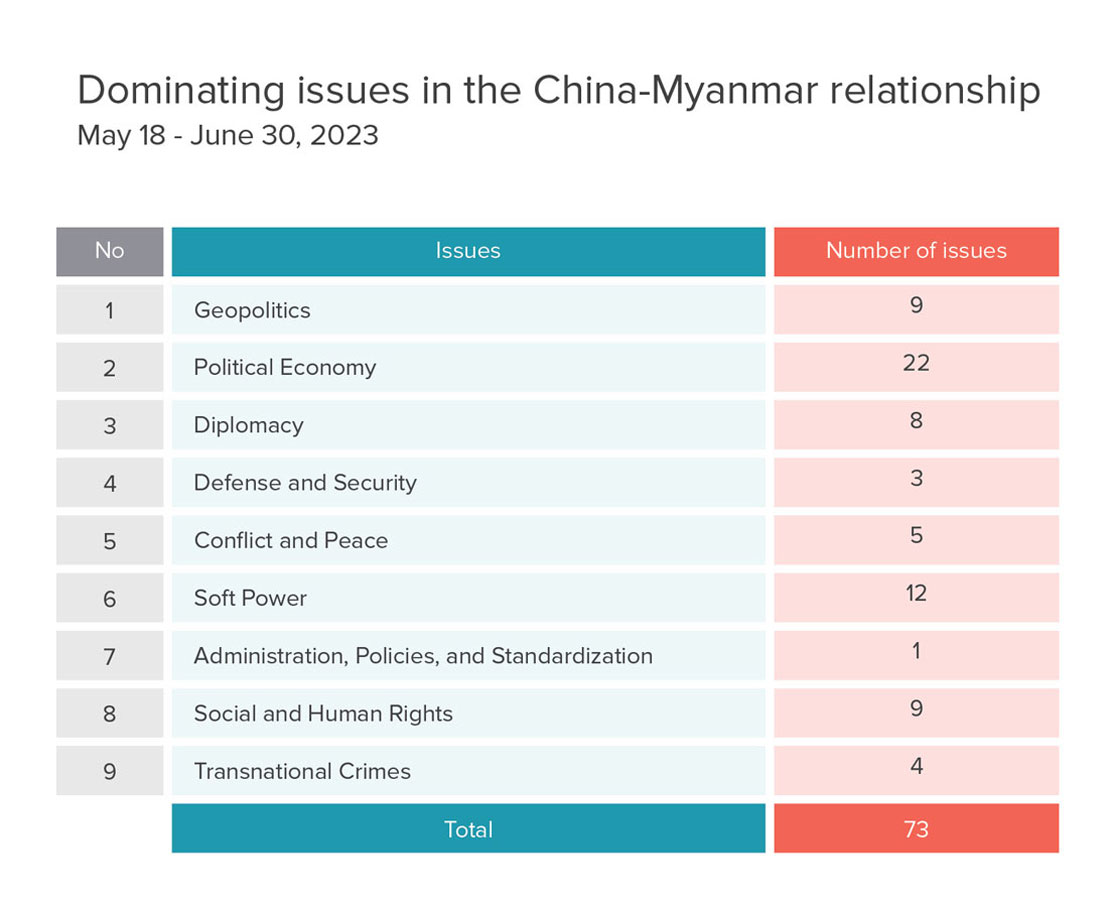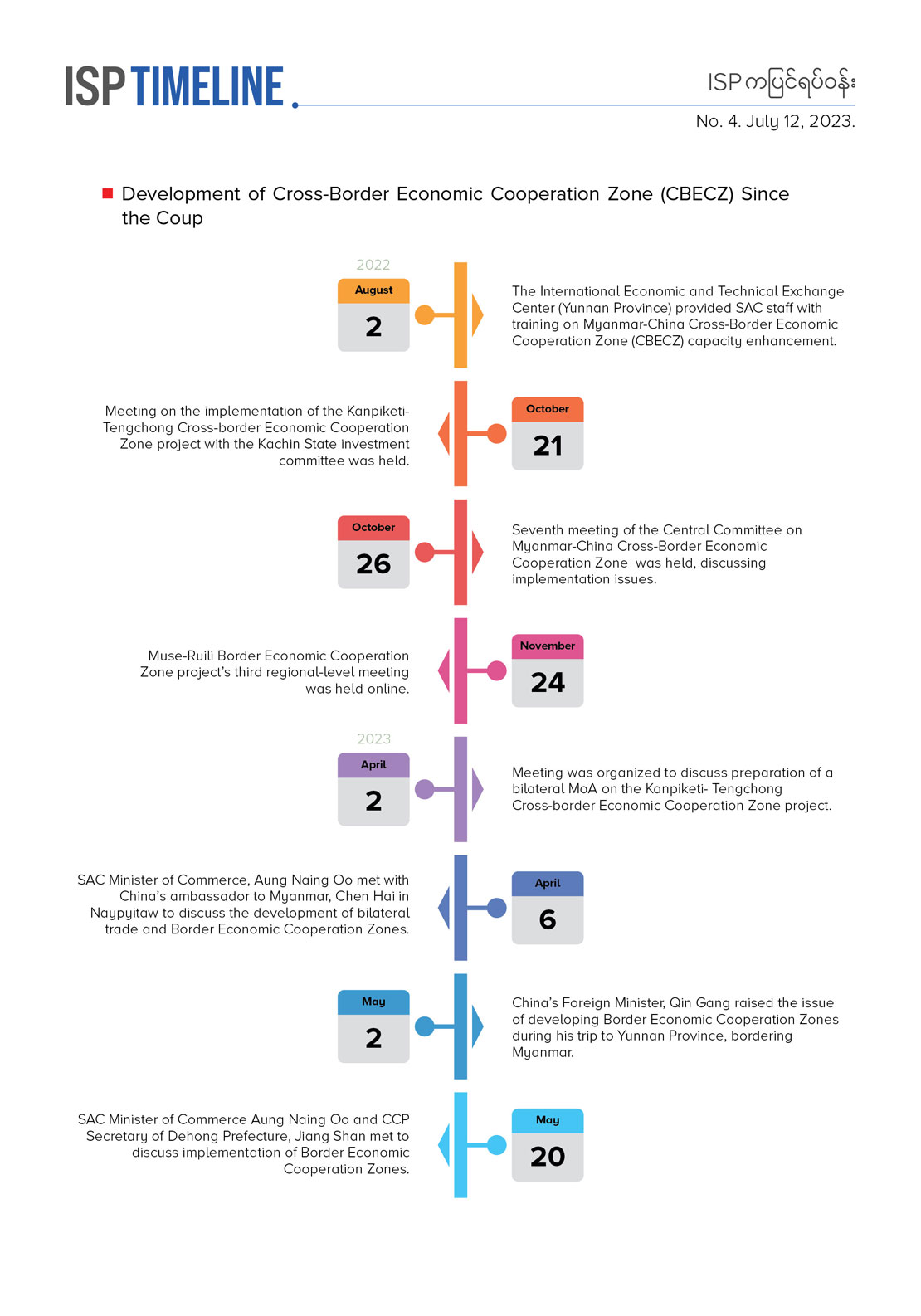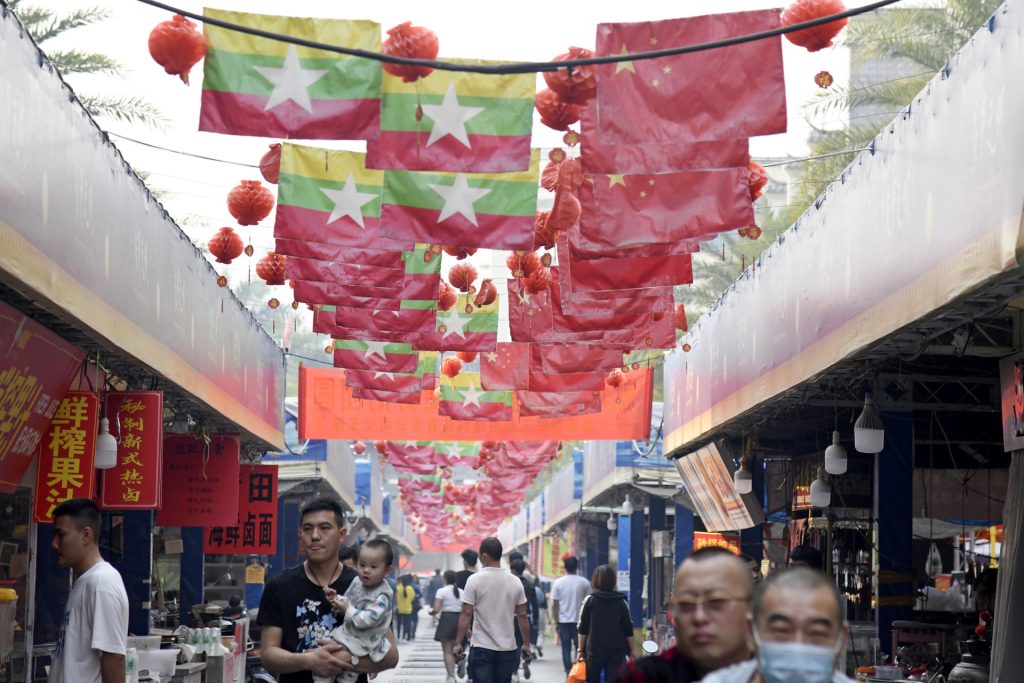ISP Explainer No. 04
(This article is a translation of the original Burmese language version that ISP-Myanmar posted on its Facebook page on July 12, 2023.)
This ISP Explainer No. 4 centers on recent developments in China-Myanmar relations based on ISP-Myanmar’s timelines of notable events. One major event of concern is that of a convoy of Chinese officials who were shot while traveling along the Sadon-Kanpiketi Highway at a time when State Administration Council (SAC) forces had renewed their offensive against the Kachin Independence Army (KIA). During the same period though, we have observed more collaborative meetings between SAC ministers and authorities from China’s Yunnan province in order to advance the Cross-border Economic Cooperation Zone (CBEPZ) under the wider agenda of the China-Myanmar Economic Corridor (CMEC), and the International Land-Sea Trade Corridor (ILSTC). It also appears that China is driving greater security collaboration since President Xi Jinping proposed the Global Security Initiative. This has resulted in greater diplomatic maneuvers in the China-Myanmar bilateral relationship. Conversely, in the economic sphere China has effectively enacted ‘a decoupling strategy’ concerning its interests in Myanmar in the face of the ongoing conflict.
∎ Summary of issues around the bilateral relationship
When analyzing ISP-Myanmar’s timelines of data collected on China-Myanmar relations, from May 18 to June 30, 2023, a total of 73 significant issues were documented (See the table). Of these, the categories of political economy, soft power, geopolitics, social and human rights have been the most prominent themes of the bilateral the relationship. This ISP Explainer then would like to discuss five crucial issues in brief.


1. Attack against Chinese official convoy in Kachin State
A convoy of Chinese delegates traveling along the Sadon-Kanpiketi Highway on June 27 was fired upon. The officials were on a trip from Tengchong, Yunnan province to Myitkyina, Kachin State in order to discuss the implementation of Myitkyina Development Zone (Namjin Industrial Project) under the China-Myanmar Economic Corridor (CMEC). 7 Stars News, a media outlet based in Kachin State, reported that the convoy was fired upon after leaving Sadon Township, near Im Wan Kong village and Lanar Falls. The SAC has attributed the attack to the Kachin Independence Army (KIA). Since the military coup, the area has been secured by Waingmaw-based LIB 58 and Shwe Min’s militia group (also known as Lisu National Development Party), with a force of 70. However both the militia and the KIA have denied any involvement in the attack.
The SAC has attempted to control key roads both for military purposes and for conducting border trade with China. A day prior to the visit of the Chinese delegation there were clashes along the Sadon- Kanpiketi Highway between SAC forces and junta-controlled militia forces on one side, and KIA’s Battalion 3 on the other. The SAC forces’ offensive against the KIA started in the first week of July. The road is particularly important for the implementation of the Kanpiketi- Tengchong Cross-border Economic Coorperation Zone, the efficient flow of border trade in goods, and as a transport connection linking up with the Namjin Industrial Zone project. The shooting event has caused the Chinese government concern and is likely to result in an increased focus on security while implementing economic zones and trade corridors.
2. More frequent meetings focused on implementing trade corridors
The Cross-border Economic Cooperation Zone (CBEPZ) under the wider agenda of the China-Myanmar Economic Corridor (CMEC), and the International Land-Sea Trade Corridor (ILSTC) are currently being implemented, and on May 19, border officials from Yunnan province convened with SAC Commerce Minister, Aung Naing Oo, to discuss enhancing border trade and streamlining border checkpoints between Myanmar and China.
During their visit, Minister Aung Naing Oo and China’s ambassador to Myanmar, Chen Hai, visited major border crossings, including Mang Wein-Jiegao gate, Kyin San Kyawt-Mantman gate, Kyu Koke-Wangding gate, Nan Taw gate, and Sin Phyu gate. These crossings are key to fostering economic cooperation along the border and facilitating the establishment of Cross-Border Economic Cooperation Zones (CBECZ).
During the May 20 meeting with Dehong prefecture officials, SAC representatives engaged in discussions covering several key areas, including enhancing the infrastructure of border checkpoints, banking system development, implementing Cross-Border Economic Cooperation Zones, as well as regular trade-cooperation issues, and on curbing illegal trade activities. Chinese officials from Lancang City have been actively lobbying SAC officials to implement ILSTC projects (See ISP Explainer No.2).
One significant project currently underway is the development of the Chinshwehaw-Lancang Cross-Border Economic Cooperation Zone (CBECZ) as part of the CMEC initiative. This project is set to establish an economic link between the Mengding gate at the Yunnan border with Lancang City, deeper inland. The International Land-Sea Trade Corridor (ILSTC) is also projected to traverse through Lancang City, amplifying its strategic significance in regional trade and connectivity.
Naypyitaw hosted the China-Myanmar trade fair between May 25-28 in order to expand trade cooperation under the CMEC and ILSTC. At the trade fair, SAC Minister of National Planning and Finance, Win Shein expressed commitment to promoting infrastructure development for the CMEC scheme and for the building of Cross-Border Economic Cooperation Zones.
The officials present also emphasized the importance of exploring markets for Myanmar products and advocated for China to consider relaxing trade barriers in line with existing regional and bilateral agreements. In a related development, AJ Myanmar Co. Ltd. and Shenyang Tianfeng Bio-Pharm Company Co. Ltd. signed an MoU on bilateral trade, and Yoma Bank Co. Ltd., Fully Light Group of Companies, and Kokang Ethnic Entrepreneurs Association Incorporated (KKEEA) signed an MoU to enhance bank payment cooperation, while 17 other companies signed nine trade-related agreements at the trade fair.

In a separate event, SAC Commerce Minister Aung Naing Oo held talks with officials from China’s embassy in Naypyitaw, along with Chinese business leaders from Kunming on the issue of Myanmar goods confiscated by Chinese border authorities. Chinese customs officials at Ruili though had already auctioned off the confiscated goods on June 15-16. Meanwhile, trade in beans and pulses exported from Myanmar to China remains suspended.
3. Strengthening security cooperation
China’s President Xi Jinping proposed the Global Security Initiative (GSI) agenda in April 2022. Since then, security cooperation between the two countries has continuously deepened. On April 28, a few days prior to Chinese Foreign Minister Qin Gang’s May visit to Myanmar, the SAC Foreign Ministry made a statement affirming that Myanmar supports the GSI.
On May 19, China’s ambassador to Myanmar, Chen Hai met with about 20 media agencies from China and Myanmar at the Chinese embassy in Yangon, to explain the proposals behind the GSI. In addition, Maj. Gen. Yang Yang of China’s Central Military Commission visited Naypyitaw on May 30 and discussed “cooperation between the two armies” for the purposes of peace, tranquility, and the development of border areas. His trip marks the first visit by senior Chinese military officials since the coup.
China’s ambassador to Myanmar, Chen Hai held discussions with SAC ministers on May 31, extending China’s assistance to combat transnational crime, online fraud and gambling, human trafficking, and the illicit drug trade on the Myanmar-China and Myanmar-Thailand borders. Shortly after, on July 7, China’s Ministry of Public Security issued an order prohibiting Chinese citizens in Myanmar from working in five specific vocations relating to online fraud. As a result of this directive, Chinese citizens in Myanmar can no longer officially work in financial transactions, trading phone top-up cards and bank accounts, GOIP (GSM-Gateway) and VOIP internet connections, direct phone calling, and advertising services.
During discussions with SAC ministers, Chen Hai emphasized the significance of cooperation on the rule of law agenda, aligning with the Lancang-Mekong Cooperation initiative’s objectives and offered to host a ministerial-level meeting to foster collaboration between the two countries in matters of rule of law and security. China proposed the two countries enhance collaboration in dealing with non-traditional threats under the Lancang-Mekong Cooperation program. China also stated its hope for better cooperation in security matters between Myanmar and China in the near future, either bilaterally or through a multi-lateral platform. China is also planning to provide training for 5,000 people from developing countries to promote the rule of law in conjunction with the proposals outlined in the GSI. China is promoting an agenda that the GSI presents an opportunity for Myanmar to adopt and follow China’s standards, practices, and policies in regard to the rule of law.

4. Strengthening the diplomatic relationship
After China’s Foreign Minister Qin Gang’s visit to Myanmar, the two countries’ relationship continues to grow. On June 8, Naypyitaw held a celebration of China-Myanmar’s 73rd anniversary of diplomatic ties and reaffirmed the relationship through a four-point agreement. The agreement includes China providing online services and related resources to Government Technical College (Mandalay) and an assessment for the renovation of Aung San stadium.
Meanwhile, the two countries seem eager for greater diplomatic cooperation within ASEAN. On May 24, a Chinese Assistant Minister of Foreign Affairs, Nong Rong met with the SAC Foreign Affairs Ministry’s Permanent Secretary in Shenzhen to discuss the promotion of further collaboration in the international arena and for the repatriation of Rohingya refugees. In addition, China’s Ambassador to Myanmar, Chen Hai met with SAC Minister of International Cooperation, Ko Ko Hlaing, to discuss greater cooperation on international fronts and for stability at the borders. Moreover, the ASEAN-China senior officials’s meeting was held in Shenzhen on May 25, which SAC Foreign Affairs Ministry Permanent Secretary, Chan Aye co-chaired with China’s Assistant Minister of Foreign Affairs.
Myanmar’s opposition formally responded to this advancing of better diplomatic relations between the two countries. The opposition National Unity Consultative Council (NUCC) issued a statement on June 24, calling for a halt to arms sales and military cooperation between China and the Myanmar junta and for closer cooperation with the National Unity Government (NUG) as well as revolutionary forces within Myanmar. While China has been engaging directly with the SAC, it has also been pushing a ‘neighborhood diplomacy’ approach to resolve the crisis in Myanmar (See ISP OnPoint No. 14).
5. China’s decoupling strategy: separating China’s interests from the Myanmar conflict
China’s adoption of a ‘decoupling strategy’ has been evident, signifying a deliberate effort to disentangle its business interests from the conflict in Myanmar. On June 1-2, delegates from the Arakan Army (AA), Ta’ang National Liberation Front (TNLA), and Myanmar National Democratic Alliance Army (MNDAA-Kokang) met with SAC’s peace negotiation team in Mongla. The two sides made several proposals at the meeting and endeavored to avoid confrontation (See ISP Insight Email No.16). A month after the Mongla meeting, on July 1, the ‘Three Brotherhood Alliance’ issued a warning to refrain from undermining internationally invested projects within areas under their control (See ISP Insight Email No.18). This warning statement is linked with efforts to maintain stability in Northern Shan State where major Chinese business interests are located.
According to ISP-Myanmar data, the number of armed conflict incidents around Chinese projects is declining (See ISP Mapping No. 17). Despite this, forces under the command of the NUG are still periodically attacking SAC forces which secure Chinese projects in Myanmar. In three separate incidents over the five days from May 21-25, local people’s defense forces under the NUG attacked SAC forces around Chinese projects in Kyaukpadaung and Taungtha Townships of Mandalay, and Salingyi Township of Sagaing Region. Despite these continued attacks, the statement calling for protection of Chinese assets by the Ethnic Armed Forces of the Three Brotherhood Alliance, which is reportedly close to China, as well as evidence and data collected by ISP-Myanmar, appears to confirm the trend that China has adopted a ‘decoupling strategy,’ separating its business interests from exposure to the ongoing conflict in Myanmar.
References
7Stars News. (2023, June 28).
တရုတ်ကောင်စစ်ဝန်ရုံးယာဉ်တန်း မြန်မာဘက်ခြမ်းတွင် ပစ်ခတ်ခံရ
https://www.facebook.com/news.sevenstars/posts/pfbid02RXxyQ1UsA38qDHcnYF1YgBWVotLK4jBmj
PgANpq6Ny5FxcgraNMCHBervL4Yo3Fmlhttp://myawady.net.mm/node/40993
Kachin News Group. (2023, July 3).
ဆဒုံး – ကန်ပိုက်တီလမ်းမှာ စစ်ကောင်စီတပ် လက်အောက်ခံပြည်သူ့စစ်တပ်နဲ့ KIA တပ်တို့ကြား စစ်ရေးတင်းမာနေဆဲ
https://burmese.kachinnews.com/2023/07/03/
Myanmar National Post. (2023, May 30).
နိုင်ငံတော်စီမံအုပ်ချုပ်ရေးကောင်စီ ဒုတိယဥက္ကဋ္ဌ၊ ဒုတိယတပ်မတော်ကာကွယ်ရေးဦးစီးချုပ်၊ ကာကွယ်ရေးဦးစီးချုပ် (ကြည်း) ဒုတိယဗိုလ်ချုပ်မှူးကြီးစိုးဝင်း တရုတ်ဗဟိုစစ်ကော်မရှင်၊ ပူးတွဲစစ်ဦးစီးဌာန၊ ခေတ္တစစ်ဘက်ထောက်လှမ်းရေး ညွှန်ကြားရေးမှူးချုပ် ဦးဆောင်သော ကိုယ်စားလှယ်အဖွဲ့အား လက်ခံတွေ့ဆုံ
https://www.mmnationalpost.com/2023/05/blog-post_4418.html
The 74 Media. (2022, October 31).
ဝိုင်းမော် – ကန်ပိုင်တီလမ်းမပေါ်ရှိ စစ်ကောင်စီပူးပေါင်းစခန်းကို KIA-PDF သွားရောက်တိုက်ခိုက်. https://www.facebook.com/The74Media/posts/pfbid02TFZj5cADzUAoiuncQcG61F
qch3X79MsfufsK2PYBamtpTg5darn8VtbEdSgci8xGl
ကောင်းကောင်း. (ဧပြီ ၉၊ ၂၀၂၃).
တရုတ် – မြန်မာနယ်စပ် ကံပိုင်တည်စီးပွားရေးနယ်မြေစီမံကိန်း အကောင်အထည်ဖော်ရေး MoA စာချုပ်မူကြမ်းပါ အချက်များညှိနှိုင်းဆွေးနွေး [ကွန်ရက်ပေါက်ဖော်].
http://www.paukphaw.com/index.php?m=article&f=view&id=4962
မြန်မာ့အလင်း. (ဇွန် ၃၀၊ ၂၀၂၃).
ကချင်ပြည်နယ် မြစ်ကြီးနားမြို့အနီး နန်းကျင်စီးပွားရေးဇုန်တည်ဆောက်ရေး ဆွေးနွေးရန်အတွက် တရုတ်နိုင်ငံမှ ကောင်စစ်ဝန်တစ်ဦးပါဝင်သည့်အဖွဲ့အား နယ်ခြားစောင့်တပ်မှပစ်ခတ်သည်ဟု မီဒီယာများ၏ စွပ်စွဲချက်နှင့်ပတ်သက်၍ နိုင်ငံတော်စီမံအုပ်ချုပ်ရေးကောင်စီ သတင်းထုတ်ပြန်ရေးအဖွဲ့ ခေါင်းဆောင် ဗိုလ်ချုပ်ဇော်မင်းထွန်း ဖြေကြားချက်.
https://www.moi.gov.mm/mal/30-jun-23
မြဝတီသတင်းစာ. (၂၆-၅-၂၀၂၃). ၂၆-၅-၂၀၂၃ ရက်နေ့ မြဝတီသတင်းစာ | Myawady Webportal.
http://myawady.net.mm/node/40993
中評動態. (2023, July 7). 駐緬甸使館:警惕涉嫌電詐犯罪的兼職工作.
http://hk.crntt.com/crn-webapp/touch/detail.jsp?coluid=7&kindid=0&docid=106712101
Ministry of Foreign Affairs of the People’s Republic of China. (2023, February 21). The Global Security Initiative Concept Paper. Retrieved from https://www.fmprc.gov.cn/mfa_eng/wjbxw/202302/t20230221_11028348.html
Xinhua. (2022, April 21). Xi Focus: Xi proposes Global Security Initiative. Retrieved from
https://english.news.cn/20220421/2c0c40da15af4dbeabb1df4d8a9911be/c.html
သားညွန့်ဦး. (2023, May 24).
မန္တလေးတိုင်းတွင်း ဓာတ်ငွေ့ပိုက်လိုင်းလုံခြုံရေးကင်း တိုက်ခိုက်ခံရ. Retrieved from
VOA Burmese website: https://burmese.voanews.com/a/mandalay-china-pipeline-security-attack/7105828.html
Ministry of Foreign Affairs Myanmar. (2023, April 28).
တရုတ်ပြည်သူ့သမ္မတနိုင်ငံသမ္မတ မစ္စတာရှီကျင့်ဖျင်၏ ကမ္ဘာလုံးဆိုင်ရာ လုံခြုံရေးအစီအမံ (Global Security Initiative-GSI) အပေါ် မြန်မာနိုင်ငံ၏ရပ်တည်ချက်. Retrieved from https://www.facebook.com/mofamyanmar/posts/pfbid0xax6hRiQLHuET6u7
eMwaGUfJkaWF9iQfFad1RfvSHSE1tyQPBnCf6GXeYhvrsxowl

